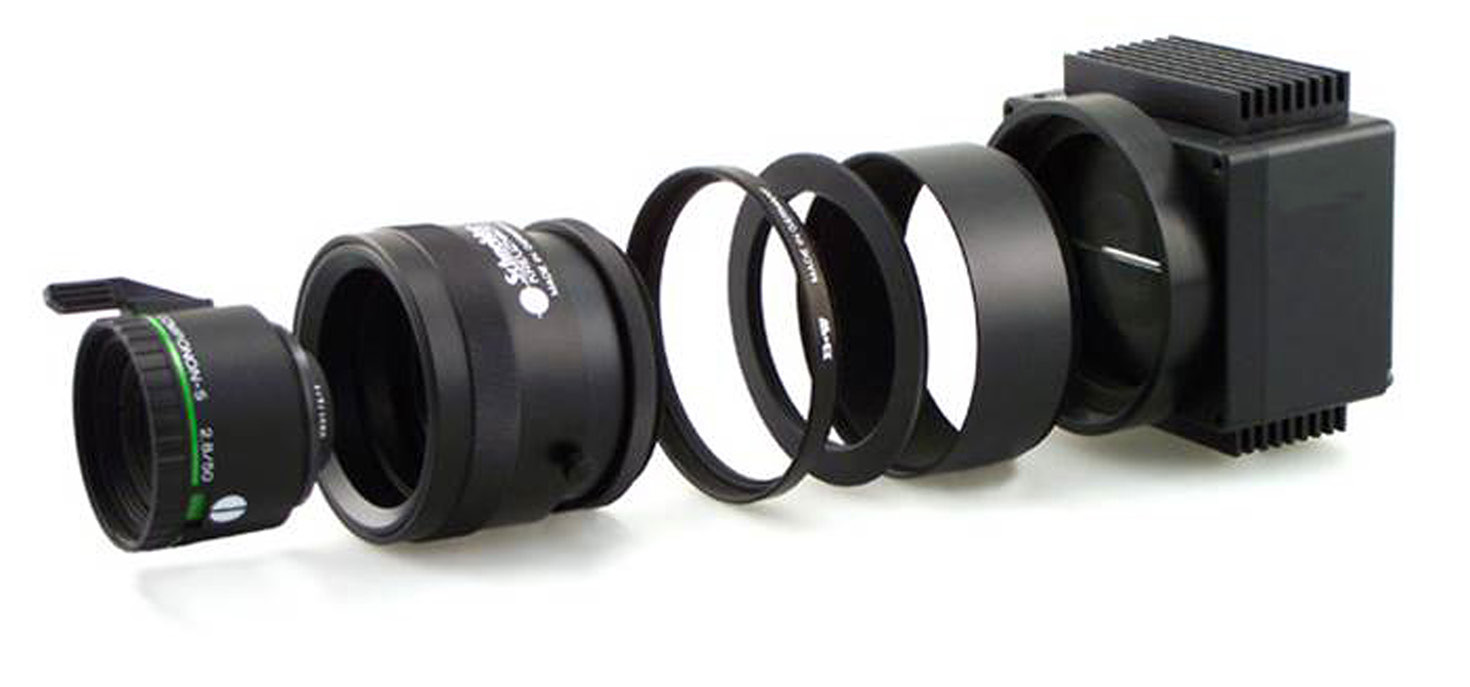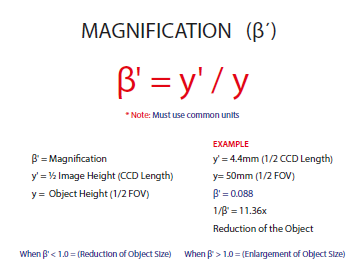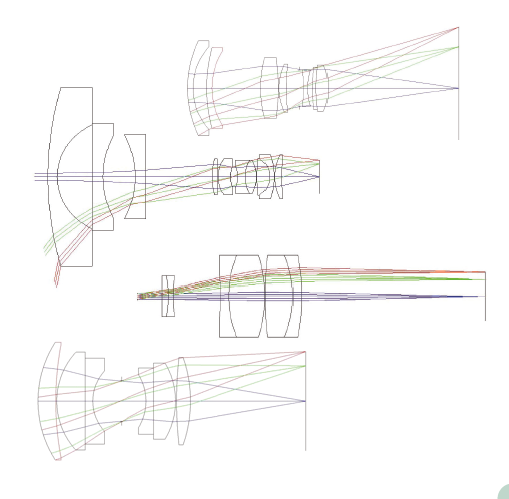From there, your optics expert can dig deeper. In this particular scenario, we would immediately dig into the desired contrast of the defects. Are they low contrast? Is the object starved for light, or is it well lit? In fact, we have 18 questions, and each helps us identify and further refine the family of lens that best suits the design specs and performance needs of the vision system.
Here are five for starters:
1. What is the desired object size or field of view (length, width, height)?
2. What are the image (area or linear; length, width, height; number of pixels) requirements?
3. What is the desired magnification?
4. What are the sensor (color or black and white, pixel size, IR block filter) specifications?
5. What is the wavelength region (monochromatic, visible, near IR)?
The answers to each of these questions further qualify the lens selection process, impacting the overall system design. So, while developers of machine vision and robotic vision systems typically come to an optics house in hopes of quickly leaving with the model number of the lens they can add to their parts list, the 18 questions often become a forcing function for a different, but necessary, kind of calculation.
Of all the questions we ask about the lens, perhaps the most important and most useful is about the required optical magnification. This ratio, generally the image size divided by the object size or field of view, immediately narrows the field of applicable lenses, identifying the family of lenses from which we can choose. If the magnification ratio is 1:1, then a macro lens is in order. These are not common. If we need to work in infinity, there are only so many lenses that can get the job done. If we find that the design needs to work in enlargement mode, the object will have to be enlarged upon the CCD or CMOS sensor, and that points to another family of lenses.
Again, better to be evaluating lens choices and assessing their impact on the total design up front in the process before commitments have been made on the other system components. Take an example in machine vision, say web inspection, where a design calls for the detection of 2-micron defects.
The customer provides a black box dimension that requires working within a meter. There’s a chance, based upon the geometry of the sensor they have selected in the camera, that there is no possible way for them to resolve the 2-micron defect. Then, they would either have to change the sensor in the camera to a different pixel size or a different number of pixels, or choose a completely different camera — or live with working farther away or closer to the object. They would really have to give up on something.
If none of these compromises are palatable, a bigger one might be in order. The lens that works within the parameters dictated by the camera, sensor, working distance, and light might only be able to resolve defects of 3.5 microns. You can guess how the resulting conversation will go.
Of course, you might be tempted to ask about custom lens development. Instead of sacrificing on key parameters that would impact the overall quality and performance of the vision system, why not build the right lens for the job? The problem of course is time — and money — both of which typically are in short supply at this point. Developing a custom lens for your system could take a year (an alternative, revising an existing lens for the job, could take six months). Custom development is a long cycle involving initial spec development, quotes, prototype development, prototype evaluation, and serial production. And a lot goes into each step. We are often asked if we can deliver a quote on a custom lens in a week. NOOOO! The initial spec process typically takes one to four weeks, with the quote process taking an additional six to eight weeks. Trust us, done right, this is a very involved process, and a custom lens must be done right.
So how many vision system design teams can accommodate an extra year in the development cycle? Or, better put, why didn’t they ask about the lens first? The real answer here is that experienced system designers have learned to ask about the lens earlier in the design process or have come to rely on the minor miracles their optical reps perform on a daily basis that get them to 80 to 90 percent satisfaction of their initial design specs.
That doesn’t mean, however, that the fundamental problem of “leaving the lens until the end” is abating. Here are a few common traps that are taking a heavy toll on designers of vision systems today:
1. Big sensors
Sensors in cameras are getting bigger and bigger. When we came up in the industry, 8k was a large sensor, and there are many of those available today, but 12k and 16k sensors are becoming prevalent, too. Now we get calls from customers saying they have a 16k array, which means a long linear array of pixels, maybe 80 mm long. This requires a lens that can form a very big image circle. But here’s the problem: they want a field of view of 5 mm. So, using the magnification calculation we reviewed earlier (magnification equals the array length over the object size), we calculate a 16x enlargement. It turns out that what they are really asking for is a lowpowered microscope that fills this huge sensor! There are no lenses that can work in these large magnification ranges over these huge sensors. There are lenses for 16x enlargement with small sensors, but not for the large ones. They just don’t exist.
2. Resolution
A design team wants to use a 5-megapixel C-mount sensor, which typically consists of 3.5 micron square pixels. They need a lens that must absolutely resolve a 1-micron defect. At a minimum, two pixels are needed to cover the defect (one “on,” one “off”), so that an edge of the defect can be seen. Let’s take, for example, a pixel size (PS) = 3.5 microns and the defect to be resolved to = 1 micron. Since we need two pixels to cover the defect, then one pixel sample size (PSS) in object space is 1 ÷ 2 = 0.5 microns. The magnification of the system = PS ÷ PSS = 3.5/0.5 = 7x enlargement. Another low-powered microscope! But here’s the bigger problem: In object space (what the lens is looking at at this 7x magnification), they want the lens — each pixel — to resolve half a micron. Once we calculate the resolution, the lens has to resolve 1,000 line pairs per millimeter in object space. There is no off-theshelf commercial lens that can do that. There is not enough resolution. We’re talking about a custom lens.
3. Working distance
Many teams trip up on working distance. They come to their optics partner with many of their specs ticked and tied, the camera, the field of view, the pixel size and sensor length, but they want to leave the working distance up to the optics rep. In this case, if we were to do our calculations for them, we could find a lens that delivers everything they want, but requires they work at 250 mm away. Suddenly, “No, guys, you choose,” turns into “but I need to work 100mm away!” Once the working distance is blown, so, too, are their black box dimensions.
A Bad Habit Worth Breaking
Over the last 20 years, we have come across innumerable instances of painful design decisions resulting from ignoring lens considerations until the last minute. We wish we could say this phenomenon was winding down, that “lessons had been learned,” and a new Golden Age of concurrent engineering was upon us.
It isn’t. Every day adds to our arsenal of anecdotes, forcing tough compromises on experienced and young engineering teams alike. Our advice? Don’t be like them. The lens is too important to the success of your vision system to be treated as an afterthought. Bring the lens to the forefront of your design planning, make concurrent engineering your new normal, and begin building your best vision systems yet.




